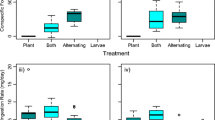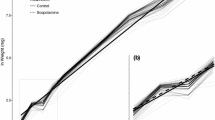Abstract
Foraging on a variety of different food items allows individuals to balance nutrient intake, but it also may dilute toxins present in single items of the diet. The distinction between nutrient balancing and toxin dilution becomes less clear, however, for organisms that sequester potentially toxic compounds for their own benefit. Additionally, specific dietary components chosen may or may not affect metabolic rate, growth, and other measures of fitness. Using the arctiid moth Utetheisa ornatrix, we (1) evaluated the temporal pattern of larval feeding behavior when presented with diet enriched with the pyrrolizidine alkaloid (PA), monocrotaline, (2) estimated the cost of ingesting PAs by measuring larval nutritional performance on diets containing different amounts of usaramine, and (3) investigated the magnitude of genetic effects on the performance of families raised on diets of different usaramine concentrations. We demonstrate that an herbivorous insect can temporally vary its intake of sequestered allelochemical. Individuals combined a preference for intermediate amounts of monocrotaline with temporal modulation of the specific amount of PA ingested on a given day. Using usaramine, we found little evidence for a cost of ingesting PAs, except among some family groups. Measures of digestive and metabolic efficiency showed no consistent reduction in performance on higher alkaloid diets. Only when larvae in family groups were fed a single concentration of PA over more than one instar was there any evidence for a cost of ingestion. Additionally, there were large genetic components to both growth and an individual's growth response to dietary alkaloid. These results suggest that while genetic variation in performance on alkaloid-rich diets exists, modulation of intake rate by caterpillars may be an important mechanism to reduce effects on the growth and fitness of individuals.
Similar content being viewed by others
REFERENCES
Bogner, F., and Eisner, T.1991. Chemical basis of egg cannibalism in a caterpillar (Utetheisa ornatrix). J. Chem. Ecol.17:2063–2075.
BopprÉ, M.1986. Insects pharmacophagously utilizing defensive plant chemicals (Pyrrolizidine alkaloids). Naturwissenschaften73:17–26.
BopprÉ, M.1990. Lepidoptera and pyrrolizidine alkaloids: Exemplification of complexity in chemical ecology. J. Chem. Ecol.16:165–186.
Bowers, M. D.1992. The evolution of unpalatability and the cost of chemical defense in insects, pp. 216–244, inB. D. Roitberg and M. B. Isman (eds.). Insect Chemical Ecology, An Evolutionary Approach. Chapman and Hall, New York.
Brower, L. P., Seiber, J. N., Nelson, C. J., Lynch, S. P., and Holland, M.M.1984. Plant determined variation in the cardenolide content, thin-layer chromatography profiles, and emetic potency of monarch butterflies, Danaus plexippusL., reared on milkweed plants in California Asclepias speciosa. J. Chem. Ecol.10:601–630.
Brown, K. S., Jr.1984. Adult-obtained pyrrolizidine alkaloids defend ithomiine butterflies against a spider predator. Nature309:707–709.
Camara, M.1997. Physiological mechanisms underlying the costs of chemical defense in Junonia coeniaHubner (Nymphalidae): A gravimetric and quantitative genetic analysis. Evol. Ecol.11:451–469.
Conner, W. E., Eisner, T., Vander Meer, R. K., Guerrero, A., and Meinwald, J.1981. Precopulatory sexual interaction in an arctiid moth (Utetheisa ornatrix): Role of a pheromone derived from dietary alkaloids. Behav. Ecol. Sociobiol.9:227–235.
Cresswell, J. E., Merritt, S. Z., and Martin, M. M.1992. The effect of dietary nicotine on the allocation of assimilated food to energy metabolism and growth of fourth-instar larvae of the southern armyworm, Spodoptera eridania(Lepidoptera: Noctuidae). Oecologia89:449–453.
Culvenor, C. C. J., and Fitzgerald, S. S.1963. A field method for alkaloid screening of plants. J. Pharm. Sci.52:303–304.
Dearing, M. D., and Schall, J. J.1992. Testing models of optimal diet assembly by the generalist herbivorous lizard Cnemidophorus murinus. Ecology73:845–858.
Dussourd, D. E., Ubik K., Harvis, C., Resch, J., Meinwald, J., and Eisner, T.1988. Biparental endowment of eggs with acquired plant alkaloid in the moth Utetheisa ornatrix. Proc. Natl. Acad. Sci. USA85:5992–5996.
Dussourd, D. E., Harvis, C., Meinwald, J., and Eisner, T.1989. Paternal allocation of sequestered plant pyrrolizidine alkaloids to eggs in the danaine butterfly, Danaus gilippus. Experientia45:896–989.
Eisner, T.1980. Chemistry, defense, and survival: case studies and selected topics, pp. 847–878, inM. Locke and D. S. Smith (eds.). Insect Biology and the Future. Academic Press, New York.
Eisner, T., and Meinwald, J.1987. Alkaloid-derived pheromones and sexual selection in lepidoptera, pp. 251–269, inG. D. Pretwich and G. J. Blomquist (eds.). Pheromone Biochemistry. Academic Press, New York.
Freeland, W. J., and Janzen, D. H.1974. Strategies in herbivory by mammals: The role of plant secondary compounds. Am. Nat.108:269–289.
Hartmann, T.1991. Alkaloids, pp. 79–121, inG. A. Rosenthal, and M. R. Berenbaum (eds.). Herbivores: Their Interactions with Secondary Plant Metabolites, Vol. I. Academic Press, New York.
Johnson, K. S., and Felton, G. W.1996. Potential influence of midgut pH and redox potential on protein utilization in insect herbivores. Arch. Insect. Biochem. Physiol.32:85–105.
Johnson, A. E., Moylneux, R. J., and Merrill, G.B.1985. Chemistry of toxic range plants.Variation in pyrrolizidine alkaloid content of Senecio, Amsinckiaand Crotalariaspecies. J. Agric. Food. Chem.33:50–55.
Leeson, S., and Caston, L. J.1991. Response of two strains of turkey hens to various protein and energy feeding programs. Poult. Sci.70:1739–1747.
Pennings, S. C., Nadeau, M. T., and Paul, V. J.1993. Selectivity of the generalist herbivore Dolabella auriculariafeeding upon complementary resources. Ecology74:879–890.
Pyke, G. H., Pulliam, H. R., and Charnov, E. L.1977. Optimal foraging: a selective review of theory and tests. Q. Rev. Biol.52:137–154.
Rapport, D. J.1980. Optimal foraging for complementary resources. Am. Nat.116:324–346.
SAS Institute. 1989. SAS/STAT User' Guide, Ver. 6, 4th ed., Vol. 2. SAS Institute Inc., Cary, North Carolina.
Schmidt, D. J., and Reese, J. C.1986. Sources of error in nutritional index studies of insects on artificial diets. J. Insect Phyisol.32:193–198.
Schultz, J. C., and Lechowicz, M. J.1986. Host plant, larval age, and feeding behavior influence midgut pH in the gypsy moth (Lymantria dispar). Oecologia71:133–137.
Scriber, J. M., and Slansky, F., Jr.1981. The nutritional ecology of immature insects. Annu. Rev. Entomol.26:183–211.
Simpson, S. J., and Simpson, C.L.1990. The mechanisms of nutritional compensation by phytophagous insects, pp. 111–116, inE. A. Bernays (ed.). Insect–Plant Interactions, Vol III. CRC Press, Boca Raton, Florida.
Slansky, F., Jr.1994. Nutritional ecology: the fundamental quest for nutrients, pp. 29–91, inN. E. Stamp, and T. M. Casey (eds.). Caterpillars, Ecological and Evolutionary Constraints on Foraging. Chapman and Hall, New York.
Speiser, B., and Rowell-rahier, M.1991. Effects of food availability, nutritional value, and alkaloids on food choice in the generalist herbivore Arianta arbustorum(Gastropoda: Helicidae). Oecologia62:306–318.
Stephens, D. W., and Krebs, J. R.1986. Foraging Theory. Princeton University Press, Princeton, New Jersey.
Stevens, J.1996. Applied Multivariate Statistics for the Social Sciences, 3rd ed. Lawrence Erlbaum Assoc., Mahwah, New Jersey.
Van Loon, J.1991. Measuring food utilization in plant-feeding insects-toward a metabolic and dynamic approach, pp. 79–124, inE. Bernays (ed.). Insect-Plant Interactions, Vol. III. CRC Press, Boca Raton, Florida.
Waldbauer, G. P., and Freidman, S.1991. Self-selection of optimal diets by insects. Annu. Rev. Entomol.36:43–63.
Westoby, M.1978. What are the biological bases of varied diets? Am. Nat.112:627–631.
Wink, M., and Schneider, D.1988. Carrier-mediated uptake of pyrrolyzidine alkaloids in larvae of the aposematic and alkaloid-exploiting moth Creatonotus. Naturwissenschaften74:524–525.
Wink, M., and Schneider, D.1990. Fate of plant-derived secondary metabolites in three moth species (Syntomis mogadorensis, Syntomeida epilais, and Creatonotos transiens). J. Comp. Physiol. B160:389–400.
Author information
Authors and Affiliations
Corresponding author
Rights and permissions
About this article
Cite this article
Kelley, K.C., Johnson, K.S. & Murray, M. Temporal Modulation of Pyrrolizidine Alkaloid Intake and Genetic Variation in Performance of Utetheisa ornatrix Caterpillars. J Chem Ecol 28, 669–685 (2002). https://doi.org/10.1023/A:1015224407041
Issue Date:
DOI: https://doi.org/10.1023/A:1015224407041




